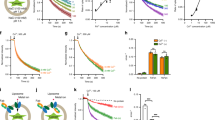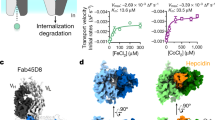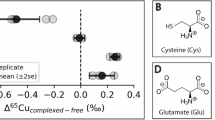Abstract
Transferrins transport Fe3+ and other metal ions in mononuclear-binding sites. We present the first evidence that a member of the transferrin superfamily is able to recognize multi-nuclear oxo-metal clusters, small mineral fragments that are the most abundant forms of many metals in the environment. We show that the ferric ion–binding protein from Neisseria gonorrhoeae (nFbp) readily binds clusters of Fe3+, Ti4+, Zr4+ or Hf4+ in solution. The 1.7 Å resolution crystal structure of Hf–nFbp reveals three distinct types of clusters in an open, positively charged cleft between two hinged protein domains. A di-tyrosyl cluster nucleation motif (Tyr195-Tyr196) is situated at the bottom of this cleft and binds either a trinuclear oxo-Hf cluster, which is capped by phosphate, or a pentanuclear cluster, which in turn can be capped with phosphate. This first high-resolution structure of a protein–mineral interface suggests a novel metal-uptake mechanism and provides a model for protein-mediated mineralization/dissimilation, which plays a critical role in geochemical processes.
NOTE: In the version of this article initially published online, the institution affiliations were assigned incorrectly because of a mistake that occurred during production. The correct affiliations for all authors are as follows: Dmitriy Alexeev1, Haizhong Zhu2, Maolin Guo2,3, Weiqing Zhong2,4, Dominic J.B. Hunter2, Weiping Yang2,3, Dominic J. Campopiano2 and Peter J. Sadler2. All of the footnotes (corrected) are as follows: 1Institute of Cell and Molecular Biology, Michael Swann Building, University of Edinburgh, Mayfield Road, Edinburgh EH9 3JR, UK; 2School of Chemistry, University of Edinburgh, West Mains Road, Edinburgh EH9 3JJ, UK; 3Current address: Department of Molecular Biology and Biochemistry, University of California, Irvine, California 92697, USA; and 4Current address: School of Pharmacy, Second Military Medicine University, Shanghai 200433, China. We apologize for any inconvenience this may have caused. This mistake has been corrected in the HTML and print version of the article.
This is a preview of subscription content, access via your institution
Access options
Subscribe to this journal
Receive 12 print issues and online access
$189.00 per year
only $15.75 per issue
Buy this article
- Purchase on Springer Link
- Instant access to full article PDF
Prices may be subject to local taxes which are calculated during checkout



Similar content being viewed by others
Change history
07 March 2003
This was incorrect in AOP version but corrected in print. Revised author affiliation numbers and affiliation information as per the note.
References
Pennisi, E. Geobiologists: as diverse as the bugs they study. Science 296, 1058–1060 (2002).
Mann, S. Biomineralization: Principles and Concepts in Bioinorganic Materials Chemistry (Oxford University Press, New York; 2001).
Newmann, D.K. & Banfield, J.F. Geomicrobiology: how molecular-scale interactions underpin biogeochemical systems. Science 296, 1071–1077 (2002).
Butler, A. Acquisition and utilization of transition metal ions by marine organisms. Science 281, 207–210 (1998).
Ratledge, C. & Dover, L.G. Iron metabolism in pathogenic bacteria. Annu. Rev. Microbiol. 54, 881–941 (2000).
Crichton, R.R. Inorganic Biochemistry of Iron Metabolism (Ellis Horwood, New York; 1991).
Bruns, C.M. et al. Fe+3-binding protein reveals convergent evolution within a superfamily. Nat. Struct. Biol. 4, 919–924 (1997).
Bruns, C.M. et al. Crystallographic and biochemical analyses of the metal-free Haemophilus influenzae Fe3+-binding protein Biochemistry 40, 15631–15637 (2001).
Taboy, C.H., Vaughan, K.G., Mietzner, T.A., Aisen, P. & Crumbliss, A.L. Fe3+ Coordination and redox properties of a bacterial transferrin. J. Biol. Chem. 276, 2719–2724 (2001).
Aisen, P. Iron metabolism: an evolutionary perspective. in Iron Metabolism in Health and Disease (eds. Brock, J. H., Halliday, J.W., Pippard, M.J. & Powell, L.W.) 1–30 (W.B. Saunders Co., London; 1994).
Sun, H., Cox, M.C., Li, H. & Sadler, P.J. Rationalisation of metal binding to transferrin: prediction of metal-protein stability constants. Struct. Bonding 88, 71–102 (1997).
Yang, X.J. & Pin, C. A novel solid-phase extraction scheme for the group separation of high field strength elements (Nb, Ta, Zr, Hf) from Al-, Ti-, and Fe-rich geological materials. Sep. Sci. Technol. 36, 571–585 (2001).
Schwietert, C.W. & McCue, J.P. Coordination compounds in medicinal chemistry. Coord. Chem. Rev. 184, 67–89 (1999).
Guo, M., Sun, H., McArdle, H.J., Gambling, L. & Sadler, P.J. Ti(IV) uptake and release by human serum transferrin and recognition of Ti(IV)-transferrin by cancer cells: understanding the mechanism of action of the anticancer drug titanocene dichloride. Biochemistry 39, 10023–10033 (2000).
Then, G.M., Appel, H., Duffield, J., Taylor, D.M. & Thies, W.-G. In vivo and in vitro studies of hafnium-binding to rat serum transferrin. J. Inorg. Biochem. 27, 255–270 (1986).
Ruh, R. & Corfield, P.W.R. Crystal structure of monoclinic hafnia and comparison with monoclinic zirconia. J. Am. Ceram. Soc. 53, 126–129 (1970).
Evans, W.J., Ansari, M.A. & Ziller, J.W. Isolation and structural characterization of the polymetallic zirconium alkoxide complexes, Zr3O(OCH2CMe3)9Cl, Zr3O(OCMe3)9(OH), and Na4Zr6O2(OEt)24 . Polyhedron 17, 869–877 (1998).
Starikova, Z.A. et al. Structural study of zirconium and hafnium oxoalkoxides. Polyhedron 18, 941–947 (1999).
Schmid, B. et al. Structure of a cofactor-deficient nitrogenase MoFe protein. Science 296, 352–356 (2002).
Mizutani, K., Yamashita, H., Kurokawa, H., Mikami, B. & Hirose, M. Alternative structural state of transferrin. The crystallographic analysis of iron-loaded but domain-opened ovotransferrin N-lobe. J. Biol. Chem. 247, 10190–10194 (1999).
Khan, J.A., Kumar, P., Srinivasan, A. & Singh, T.P. Protein intermediate trapped by the simultaneous crystallization process. Crystal structure of an iron-saturated intermediate in the Fe3+ binding pathway of camel lactoferrin at 2.7 Å resolution. J. Biol. Chem. 276, 36817–36823 (2001).
Kuser, P. et al. The mechanism of iron uptake by transferrins: the X-ray structures of the 18 kDa NII domain fragment of duck ovotransferrin and its nitrilotriacetate complex. Acta Crystallogr. D 58, 777–783 (2002).
Grossmann, J.G. et al. Metal-induced conformational changes in transferrins. J. Mol. Biol. 229, 585–590 (1993).
Jeffrey, P.D. et al. Ligand-induced conformational change in transferrins: crystal structure of the open form of the N-terminal half-molecule of human transferrin. Biochemistry 37, 13978–13986 (1998).
Nowalk, A.J., Vaughan, K.G., Day, B.W., Tencza, S.B. & Mietzner, T.A. Metal-dependent conformers of the periplasmic ferric ion binding protein. Biochemistry 36, 13054–13059 (1997).
Guo, M. Proteins and nucleic acids as targets for titanium(IV). PhD thesis, Univ. Edinburgh (2000).
Frausto da Silva, J.J.R. & Williams, R.J.P. The principles of the uptake and chemical speciation of the elements in biology. in The Biological Chemistry of the Elements. Chapter 2, 23–70 (Oxford University Press, Oxford; 1991).
Ferreiros, C., Criado, M.T. & Gomez, J.A. The Neisserial 37 kDa ferric binding protein (FbpA). Comp. Biochem. Physiol. Biochem. Mol. Biol. 123, 1–7 (1999).
Heidelberg, J.F. et al. Genome sequence of the dissimilatory metal ion-reducing bacterium Shewanella oneidensis. Nat. Biotechnol. 20, 1118–1123 (2002).
Guo, M. et al. Synergistic anion and metal binding to the ferric-ion binding protein from Neisseria gonorrheae (nFBP). J. Biol. Chem. 278, 2490–2502 (2003).
Nowalk, A., Tencza, S. & Mietzner, T. Coordination of iron by the ferric iron-binding protein of pathogenic Neisseria is homologous to the transferrins. Biochemistry 33, 12769–12775 (1994).
Otwinowski, Z. & Minor, W. Processing of X-ray diffraction data collected in oscillation mode. Methods Enzymol. 276, 307–326 (1997).
Collaborative Computational Project, Number 4. The CCP4 suite: programs for protein crystallography. Acta Crystallogr. D 50, 760–763 (1994).
Brunger, A.T. et al. Crystallography & NMR system: a new software suite for macromolecular structure determination. Acta Crystallogr. D 54, 905–921 (1998).
Navaza, J. & Saludjian, P. AMoRe: an automated molecular replacement program package. Methods Enzymol. 276, 581–594 (1997).
Jones, T.A. & Kjeldgaard, M. O Version 5.9, The Manual (Uppsala University, Uppsala; 1994).
Nicholls, A., Sharp, K.A. & Honig, B. Protein folding and association: insights from the interfacial and thermodynamic properties of hydrocarbons. Proteins 11, 281–296 (1991).
Read, R.J. Improved Fourier coefficients for maps using phases from partial structures with errors. Acta Crystallogr. A 42, 140–149 (1986).
Kraulis, P.J. MOLSCRIPT: a program to produce both detailed and schematic plots of protein structures. J. Appl. Crystallogr. 24, 945–949 (1991).
Sun, H., Li, H., Weir, R.A. & Sadler, P.J. The first specific Ti(IV)-protein complex: potential relevance to anticancer activity of titanocenes. Angew. Chem. Int. Ed. Engl. 37, 1577–1579 (1998).
Acknowledgements
We thank The Wellcome Trust (Edinburgh Protein Interaction Centre, fellowships for D.J.B.H. and W.Z., and International Research Development Award for W.Z.), Darwin Trust (fellowship for D.A.) and CVCP (ORS Awards for H.Z. and M.G.) for their support for this work, and G.G. Dodson, E.I. Stiefel, A.J. Thomson and R.J.P. Williams for their helpful comments on this script.
Author information
Authors and Affiliations
Corresponding author
Ethics declarations
Competing interests
The authors declare no competing financial interests.
Rights and permissions
About this article
Cite this article
Alexeev, D., Zhu, H., Guo, M. et al. A novel protein–mineral interface. Nat Struct Mol Biol 10, 297–302 (2003). https://doi.org/10.1038/nsb903
Received:
Accepted:
Published:
Issue Date:
DOI: https://doi.org/10.1038/nsb903
This article is cited by
-
Biosynthesis of copper carbonate nanoparticles by ureolytic fungi
Applied Microbiology and Biotechnology (2017)
-
Iron and bismuth bound human serum transferrin reveals a partially-opened conformation in the N-lobe
Scientific Reports (2012)
-
Ferric ion (hydr)oxo clusters in the “Venus flytrap” cleft of FbpA: Mössbauer, calorimetric and mass spectrometric studies
JBIC Journal of Biological Inorganic Chemistry (2012)
-
Cloning and characterization of a novel periplasmic heme-transport protein from the human pathogen Pseudomonas aeruginosa
JBIC Journal of Biological Inorganic Chemistry (2007)
-
Iron acquisition: straight up and on the rocks?
Nature Structural & Molecular Biology (2003)



